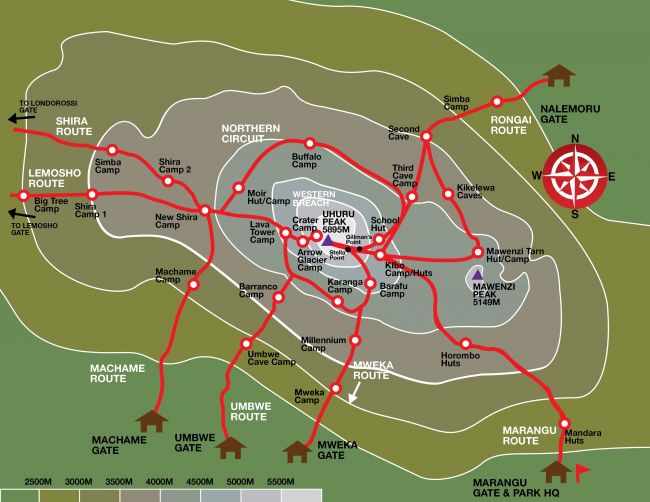Kilimanjaro Routes Overview …
Kilimanjaro Routes Overview – Pros & Cons of each Route – Route Summaries – Kilimanjaro Routes Map.
There are seven main Kilimanjaro routes that one can use to trek the highest mountain in Africa. The eighth Kilimanjaro route, Mweka, is used for decent only (see map below).
Kilimanjaro Route Map

The Machame Route and Umbwe Route depart from the south-west side of the mountain, and then use the Southern Circuit via Barafu and Stella Point to approach Uhuru Peak. Similarly, Shira Route and Lemosho Route also use the Southern Circuit to approach the summit and the Mweka route to descend; however both routes begin on the far west side off the mountain.
Marangu Route begins in the south-east and approaches Uhuru peak via Gilman’s Point. It is the only route on Kilimanjaro that has hut accommodation for the entire climb and uses the same trail to ascend and descend.
Rongai Route starts from the North-East and passes through the Saddle situated between Kibo and Mawenzi Peak to approach the summit via Gilman’s Point. The Rongai route descends via the Marangu Route.
The newest and longest route is the Northern Circuit which uses the same starting point as Lemosho but veers north before Lava Tower, circling around the north of the mountain and approaching Uhuru Peak via Gilman’s Point.
The Western Breach is a difficult trail that was closed due to a tragic rock-fall in 2006 that killed three trekkers. The route has subsequently re-opened but is seldom used by tour operators as it offers poor acclimatization, is steep and remains rather unsafe for inexperienced trekkers.
Trekkers who use the Western Breach usually approach from the Umbwe Route up to Lava Tower, before taking a steep ascent past Arrow’s Glacier and up the Western Breach to Crater Camp and Uhuru Peak. The Western Breach can also be approached using the Machame, Shira and Lemosho Route. Descent is usually via the Mweka Route.
As alluded to above, there are three assault passages to the summit of Kilimanjaro.
The first is via the southern slopes of Kibo, up to Stella Point and then west around the crater rim to Uhuru Peak. This approach is used by trekkers on the Lemosho, Shira, Machame and Umbwe Routes.
The second assault passage approaches from the Eastern side of Kibo, up to Gilman’s Point and then west around the crater rim to Uhuru Peak. Trekkers on the Rongai and Marangu Route, and Northern Circuit use this passage to the summit.
Thirdly, trekkers can use the more technically challenging approach to the summit via the Western Breach.
Kilimanjaro Route Summaries

Below we have highlighted some of the key features on each of the Kilimanjaro Routes.
Click on the individual Kilimanjaro routes to find out more information.
Machame Route (find out more)
- This route is highly recommended for scenic value and has a medium to high success rate, especially if you choose the seven day itinerary. The six-day options is not recommended for first-time trekkers
- It is a good Kilimanjaro route for acclimatization as it has a climb high, sleep low opportunity for trekkers on day three. Here trekkers climb from Shira Camp 2 to Lava Tower at 4,600 meters, where they have lunch and then back down to Barranco Camp (3,900 meters) to sleep
- Like all Kilimanjaro routes, the Machame is a challenging trek with stunning scenery through four diverse climatic zones
- There is a good opportunity to split pre-summit day climb by adding an extra rest day at Karanga Camp (only available to seven day trekkers) to leave hikers well rested before summiting
- The route has however got very popular over the past few years which means it can get busy, especially at Barranco where climbers join up with trekkers from the Lemosho, Shira and Umbwe routes
- The Machame route only offers fully catered camping
Marangu Route (find out more)
- The Marangu route was Nicknamed the ‘Coca-Cola’ route as Coke used to be bought along the way in tea huts
- The route is often selected by unprepared, inexperienced climbers as a result of the reputation for being the “easiest” route, attributing to the lower success rate
- It is also the shortest Kilimanjaro route with a relatively poor acclimatization profile, which is a major contributor to the low success rates on the Marangu. The six day itinerary does give trekkers an opportunity to climb high, sleep low; however the elevation is moderate and not as effective as other climb high, sleep low opportunities that are present on other Kilimanjaro routes
- Out of all the Kilimanjaro routes, the Marangu route is the only one with dormitory style accommodation in huts for the whole duration of the climb. The huts come with mattresses and basic amenities, making them a popular choice for budget operators who don’t have the right equipment to tackle the other Kilimanjaro routes
- The Marangu offers beautiful views from the Saddle but can be considered less scenic than other Kilimanjaro routes due to ascent and descent on same trail
Lemosho Route (find our more)
- The Lemosho is a beautiful route that departs from the West side of Mount Kilimanjaro
- Due to its route profile the Lemosho can be completed on a seven or eight day itinerary and offers lots of opportunities to properly acclimatize. Because of it’s versatile route profile it is a highly recommended Kilimanjaro route that has relatively high summit success rates
- It is also recommended as the starting point is relatively remote and hence provides trekkers with a rather untouched and wild start to their Kilimanjaro adventure. Spotting large wildlife, like antelope, buffalo and even elephant is unusual but not impossible
- The route also provides unparalleled and spectacular views of the dramatic gorges that characterize the western side of Mount Kilimanjaro
- The Lemosho offers trekkers the experience of hiking across the Shira Plateau – one of the largest high altitude plateaus in the world
- Trekkers on the Lemosho typically converge with Machame route on day 3 at Barranco camp and use the Barafu camp route to the summit; however, it is now quite common for Lemosho trekkers to veer north before Lava Tower to join the Northern Circuit which circles the north side of Mount Kilimanjaro and follows an assault passage via Gilman’s Point. The Lemosho route can also be used by trekkers planning to climb the Western Breach to the summit
- Like the Machame Route, the Lemosho is fully catered camping only
Shira Route (find out more)
- Same as Lemosho, except Shira offers higher start point and therefore poorer acclimatisation
- It is a route that we wouldn’t recommend because of it’s high start point
Rongai Route (find out more)
- The Rongai route is the only northern start point to Kilimanjaro, beginning on the North East side of Kilimanjaro National Park
- The Rongai offers a true wilderness experience on the early stages of the climb, and like the Lemosho route it is possible to see large wildlife like buffalo, antelope and elephant
- The Northern slopes tend to be dryer than the southern slopes which makes the Rongai a great Kilimanjaro Route for trekking during the wet season. However, because the northern slopes are dryer they can also be considered less scenic. That being said, a northern approach is often characterized by clear views of Kilimanjaro – something that is not that common from the southern side
- The Rongai is also a flatter route for the first few days which makes for easy trekking. The route is usually completed on a seven day itinerary but has limited climb high, sleep low opportunities which means that acclimatisation opportunities are not as good as on other Kilimanjaro routes
- Typically the Rongai route uses the passage from School Hut up past Hans Meyer Cave and Gilman’s Point to Uhuru Peak
- The route descends via the Marangu route, hence the route has fully catered camping until the last night on the mountain – beers at Horombo Hut anyone?
Umbwe Route (find out more)
- The Umbwe Route has a short and steep beginning profile up to Barranco camp where trekkers join climbers from the Lemosho, Shira and Machame route
- Some Umbwe route trekkers don’t join the southern circuit at Barranco but instead continue north, up to Lava Tower and then onto the Western Breach
- The Umbwe has poor acclimatization opportunities due to its rapid ascent and therefore success rates can be low on this Kilimanjaro route
- Fully catered camping only
Northern Circuit (find out more)
- The Northern Circuit is the longest route on Mount Kilimanjaro, and has one of the highest summit success rates as the route offers lots of climb high, sleep low opportunities, and time to acclimatise
- The route departs from same start point as Lemosho but then joins the Northern Circuit near Lava Tower, before traversing the north slopes of Mount Kilimanjaro
- The summit assault is via Gilman’s Point
- The route can be completed on an eight or nine day itinerary
Western Breach Route (find out more)
- The Western Breach Route is the most technically difficult approach to Mount Kilimanjaro, but perhaps the most rewarding!
- The approach to the Western Breach usually starts on the Umbwe Route and then continues north and up from Lava Tower
- The Western Breach was closed due to fatal rockfall in 2006, but reopened in 2007 with a new and safer route configuration. Nonetheless, many tour operators don’t offer the Western Breach on their route roster
- Only advised for experienced trekkers – it is recommended that all Western Breach climbers use helmets and it is not uncommon to need point crampons during the wet season and sub-surface ice can be an issue
- Success rates are typically moderate to high as the route is usually only tackled by experienced high altitude trekkers

